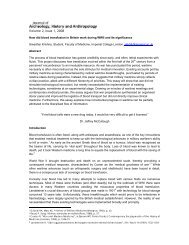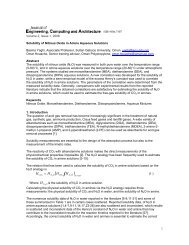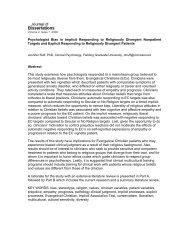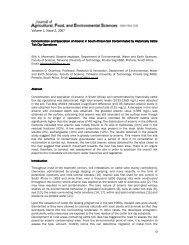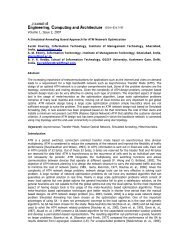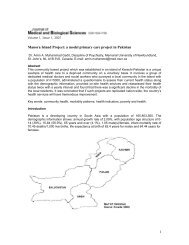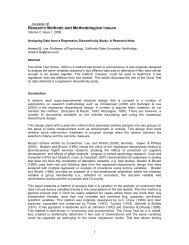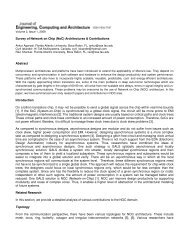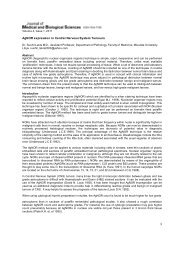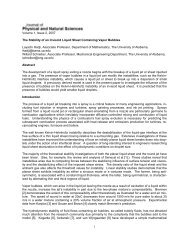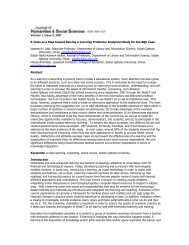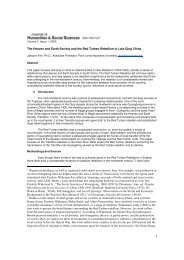Easy data template, analysis and presentation tools for complex ...
Easy data template, analysis and presentation tools for complex ...
Easy data template, analysis and presentation tools for complex ...
You also want an ePaper? Increase the reach of your titles
YUMPU automatically turns print PDFs into web optimized ePapers that Google loves.
Results<br />
An excel file was developed in a series of steps with simple <strong>for</strong>mulae to make <strong>data</strong> entry <strong>and</strong> record keeping<br />
simpler <strong>for</strong> multiparametric cell culture studies. Also, a single table <strong>for</strong>mat was developed which can serve<br />
as a <strong>template</strong> <strong>for</strong> simultaneous <strong>data</strong> entry, result re<strong>presentation</strong> <strong>and</strong> <strong>analysis</strong> of multiple parameters involved<br />
in cell culture studies.<br />
Discussion<br />
Cell cultures offer with excellent in vitro experimental models <strong>and</strong> should be well st<strong>and</strong>ardized <strong>for</strong> useful<br />
study results. [5] St<strong>and</strong>ardization of the optimal cell types <strong>and</strong> the culture types/conditions require multiple<br />
experimental variables. Data <strong>analysis</strong> <strong>and</strong> interpretation is the most important <strong>and</strong> critical part of education<br />
<strong>and</strong> research. The raw <strong>data</strong> obtained from experiments should be presented in an organized manner so that<br />
useful in<strong>for</strong>mation can be extracted from it. The excel <strong>template</strong> we describe here serves the required<br />
purpose of easy <strong>data</strong> entry along with maximum in<strong>for</strong>mation as obtained in the final <strong>template</strong>. Also, the<br />
results obtained from all the variables/combinations of the variables could be entered into the single table<br />
<strong>for</strong>mat that we describe here. The advantages of these two <strong>tools</strong> (the excel <strong>template</strong> <strong>and</strong> the single table<br />
<strong>for</strong>mat) is requirement of less time, less confusion, less error <strong>and</strong> inclusion of maximum <strong>data</strong>. In addition, the<br />
<strong>for</strong>mats are flexible to suit a variety of experimental circumstances. These inputs are designed to refine <strong>and</strong><br />
distill the <strong>data</strong> so that students <strong>and</strong> researchers can glean interesting/pertinent in<strong>for</strong>mation without the need<br />
to sort through voluminous <strong>data</strong> or a number of single entities such as graphs <strong>and</strong> tables.<br />
Conclusion<br />
Science education is a combination of imparting in<strong>for</strong>mation, instilling the need <strong>for</strong> an <strong>analysis</strong>, asking the<br />
right questions <strong>and</strong> to choose the right approach thus contributing towards knowledge enhancement. In all<br />
areas of life sciences, basic research is a vital part of science education. Cell cultures owing to their<br />
immense potentials <strong>for</strong> both teaching <strong>and</strong> learning have become important components in science curricula<br />
globally. Data <strong>analysis</strong> <strong>and</strong> interpretation is the critical part of any research which involves multiple<br />
parameters <strong>and</strong> numerous variables. The cell culture plate <strong>template</strong> designed using MS Excel <strong>and</strong> table<br />
generated using MS Word that are described here present dense <strong>data</strong> in a simplified <strong>for</strong>m. The generated<br />
<strong>data</strong> could be inspected, trans<strong>for</strong>med <strong>and</strong> modeled with the useful <strong>and</strong> most pertinent in<strong>for</strong>mation<br />
highlighted. These are intended to considerably reduce the <strong>complex</strong>ity of <strong>data</strong> record keeping, <strong>presentation</strong><br />
of the study design, <strong>analysis</strong> of results <strong>and</strong> sharing of the research findings. These <strong>tools</strong> can be very useful<br />
<strong>for</strong> both learning <strong>and</strong> teaching <strong>for</strong> practical education in biological sciences.<br />
References:<br />
[1] R. I. Freshney, A. R. Liss (1994) Culture of Animal Cells: A Manual of Basic Technique, 3rd ed., New<br />
York, Blackwell Publishing.<br />
[2] Adi F. Gazdar, Girard Luc, Lockwood William W., Wan L. Lam <strong>and</strong> John D. Minna (2010) Lung cancer<br />
cell lines as <strong>tools</strong> <strong>for</strong> biomedical discovery <strong>and</strong> research, J. Nat. Cancer Inst. 102, 1310–1321.<br />
[3] D. Z. Meyer, L. M. Avery (2009) Excel as a qualitative <strong>data</strong> <strong>analysis</strong> tool, Field Method. 21, 91–112.<br />
[4] M W. Lehman, C E. Herring (2003) Creating interactive spreadsheets to provide immediate feedback, J.<br />
Account. Educ. 21, 327–337.<br />
[5] J. H. Dunham, P. Guthmiller (2008). Doing good science: authenticating cell line identity, Cell Notice. 22,<br />
15–17.<br />
6



